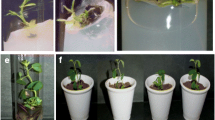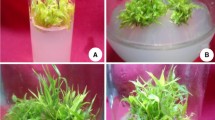Abstract
Hypericum hookerianum (Hypericaceae), a critically endangered plant of Western Ghats, India, has acquired significant importance due to its medicinal implications and ornamental flowers. This species is under severe anthropogenic pressure due to urbanization, tourism, and plantation activities taking place in their natural habitat. A clonal propagation strategy is standardized in this species which offers an opportunity for a stable production of active metabolites from this species as well as their conservation. The study deals with the optimization of axillary bud proliferation using nodal explants followed by genetic stability analysis of regenerants. Maximum number of shoots (3.66) was observed on the Murashige and Skoog (MS) medium supplemented with Kinetin (2.325 µM) with 85 % shoot multiplication frequency. In vitro grown shoots were rooted best in 1/2 MS medium supplemented with indole-3-butyric acid (2.45 µM) with an average of 6.8 ± 0.79 roots/shoot and 95.5 % rooting frequency. Plantlets were acclimatized best (90 %) in a mixture of sterile sand and farmyard manure (3:1). Micropropagated plants were subjected to random amplified polymorphic DNA analysis and phytochemical analysis to confirm their clonal stability. In RAPD analysis, 1032 amplicons were collectively generated which were monomorphic and similar to the mother plant. The comparable major phytochemical constituents in regenerants and mother plants together with genetic uniformity data obtained from RAPD analysis confirmed clonal fidelity of the regenerants. Findings in this study are the first report on micropropagation and assessment of genetic stability of micropropagated plantlets in H. hookerianum which suggests that in vitro axillary shoot proliferation can effectively be used as a tool for propagation and conservation of H. hookerianum.




Similar content being viewed by others
References
Ajithkumar D, Seeni S (1998) Rapid clonal multiplication through in vitro axillary shoot proliferation of Aegle marmelos (L.) Corr., a medicinal tree. Plant Cell Rep 17:422–426
Amoo S, Finnie JF, Van Staden J (2011) The role of meta-topolins in alleviating micropropagation problems. Plant Growth Regul 63:197–206
Ayan AK, Çirak C (2006) In vitro multiplication of Hypericum heterophyllum, an endemic Turkish species. J Plant Physiol 1:76–81
Ayan AK, Çirak C (2008) Variation of hypericins in Hypericum triquetrifolium Turra growing in different locations of Turkey during plant growth. Nat Prod Res 22:1597–1604
Ayan AK, Çirak C, Kevseroglu K, Sokmen A (2005) Effects of explants types and different concentrations of sucrose and phytohormones on plant regeneration and hypericin content in Hypericum perforatum L. Turk J Agric For 29:197–204
Bacila I, Coste A, Halmagyi A, Deliu C (2010) Micropropagation of Hypericum maculatum Cranz an important medicinal plant. Rom Biotech Lett 15:86–91
Backer W, Hart HJ, Bischoff F, Grabley S, Goedecke R, Johannisbauer W, Jordan V, Stockfleth R, Strube J, Wiesmet V (2006) Phytoextrakte-Prosukte und Prozesse. http://www.dechema.de/dechema_media/Downloads/Extraktion/Phytoextraktc.pdf
Bagdonaite E, Martonf P, Repcak ML (2010) Variation in the contents of pseudohypericin and hypericins in Hypericum perforatum from Lithuania. Biochem Syst Ecol 38:634–640
Banerjee A, Subhendu B, Sarmistha SR (2012) In vitro regeneration of Hypericum perforatum L. using thidiazuron and analysis of genetic stability of regenerants. Indian J Biotechnol 11:92–98
Baruah A, Sarma D, Saud J, Singh RS (2001) In vitro regeneration of Hypericum patulum, a medicinal plant. Indian J Exp Biol 39:947–949
Bruni R, Sacchetti G (2009) Factors affecting polyphenol biosynthesis in wild and field grown St. John’s Wort (Hypericum perforatum L. Hypericaceae/Guttiferae). Molecules 14:682–725
Cardoso MA, de Oliveira DE (1996) Tissue culture of Hypericum brasiliense Choisy: shoot multiplication and callus induction. Plant Cell Tiss Org 44:91–94
Cellarova E, Kimakova K, Brutovska R (1992) Multiple shoot formation in Hypericum perforatum L. and variability of R0. Biol Plant 101:46–50
Chandrashekhar RH, Venkatesh P, Ponnusankar S, Vijayan P (2009) Antioxidant activity of Hypericum hookerianum Wight & Arn. Nat Prod Res 23:1240–1251
Çirak C, Ayan AK, Kevseroglu K (2007) Direct and indirect regeneration of plants from internodal and leaf explants of Hypericum bupleuroides Gris. J Plant Biol 50:24–28
Coste A, Vlase L, Halmagyi A, Delieu C, Coldea G (2011) Effects of plant growth regulators and elicitors on production of secondary metabolites in shoot cultures of Hypericum hirsutum and Hypericum maculatum. Plant Cell Tiss Org 106:79–288
Crockett SL, Robson NKB (2011) Taxonomy and chemotaxonomy of the genus Hypericum. Med Aromat Plant Sci Biotechnol 5(Special Issue 1):1–13
Dongre SH, Badami S, Godavarthi A (2008) Antitumor activity of Hypericum hookerianum against DLA induced tumor in mice and its possible mechanism of action. Phytother Res 22:23–29
Goel MK, Kukreja AK, Bisht NS (2009) In vitro manipulations in St. John’s wort (Hypericum perforatum L.) for incessant and scale up micropropagation using adventitious roots in liquid medium and assessment of clonal fidelity using RAPD analysis. Plant Cell Tiss Org 96:1–9
Hu CY, Wang PJ (1983) Meristem, shoot tip, and bud cultures. In: Evans DA, Sharp WR, Ammirato PV, Yamada Y (eds) Handbook of plant cell culture: techniques for propagation and breeding, vol 1. Macmillan Publishing Co., New York, pp 177–227
Karioti A, Bilia R (2010) Hypericins as potential leads for new therapeutics. Int J Mol Sci 11:562–594
Karppinen K (2010) Biosynthesis of hypericins and hyperforins in Hypericum perforatum L. (St. John’s wort)-precursors and genes involved. Academic presentation submitted to the Faculty of Science, Department of Biology, University of Oulu, Oulu, ISSN 0355-03191
Khawale RN, Singh SK, Vimala Y, Minakshi G (2006) Assessment of clonal fidelity of micropropagated grape (Vitis vinifera L.) plants by RAPD analysis. Physiol Mol Biol Plants 12:189–192
Kirakosyan A, Sirvent TM, Gibson DM, Kaufman PB (2004) The production of hypericins and hyperforin by in vitro cultures of St. John’s wort (Hypericum perforatum). Biotechnol Appl Biochem 39:71–81
Koperdakova J, Kosuth J, Cellarova E (2007) Variation in the content of hypericins in four generations of Hypericum perforatum somaclones. J Plant Res 120:123–128
Krishnan PN, Decruse SW, Radha RK (2011) Conservation of medicinal plants of Western Ghats, India and its sustainable utilization through in vitro technology. In Vitro Cell Dev Biol Plant 47:110–122
Kusari S, Lamshoft M, Zuhlke S, Spiteller M (2008) An endophytic fungus from Hypericum perforatum that produces hypericin. J Nat Prod 71:159–162. doi:10.1021/np070669k
Kusari S, Zühlke S, Košuth J, Čellárová E, Spiteller M (2009) Light-independent metabolomics of endophytic Thielavia subthermophila provides insight into microbial hypericin biosynthesis. J Nat Prod 72:1825–1835
Mukherjee PK, Suresh B (2000) The evaluation of wound healing potential of Hypericum hookerianum leaf and stem extracts. J Altern Complement Med 6:61–69
Mukherjee PK, Saritha GS, Suresh B (2001) Antibacterial spectrum of Hypericum hookerianum. Fitoterapia 72:558–560
Murashige T, Skoog F (1962) A revised medium for rapid growth and bioassays with tobacco tissue cultures. Physiol Plant 15:473–479
Murray MG, Thompson WF (1980) Rapid isolation of high molecular weight DNA. Nucleic Acids Res 8:4321–4325
Namli S, Akbas F, Isikalan Ç, Tilkat Ayaz E, Basaran D (2010) The effect of different plant hormones (PGRs) on multiple shoots of Hypericum retusum Aucher. Plant Omics 3:12–17
Nei M (1973) Analysis of gene diversity in subdivided populations. Proc Natl Acad Sci USA 70:3321–3323
Oluk EA, Orhan S (2009) Thidiazuron induced micropropagation of Hypricum.triquetrifolium Turra. Afr J Biotechnol 8:3506–3510
Oluk EA, Orhan S, Karakas O, Cakir A, Gonuz A (2010) High efficiency indirect shoot regeneration and hypericin content in embryonic callus of Hypericum triquetrifolium Turra. Afr J Biotechnol 9:2229–2233
Padmesh P, Reji JV, Dhar MJ, Seeni S (2006) Estimation of genetic diversity in varieties of Mucuna pruriens using RAPD. Biol Plant 50:367–372
Pasqua G, Avato P, Monacelli B, Santamaria AR, Argentieri MP (2003) Metabolites in cell suspension cultures, calli, and in vitro regenerated organs of Hypericum perforatum cv Topas. Plant Sci 165:977–982
Pretto FR, Santarem ER (2000) Callus formation and plant regeneration from Hypericum perforatum L. leaves. Plant Cell Tiss Org 67:107–113
Radha RK, Varghese Amy Mary, Seeni S (2013) Conservation through in vitro propagation and restoration of Mahonia leschenaultii, an endemic tree of the Western Ghats. Sci Asia 39:219–229. doi:10.2306/scienceasia1513-1874.2013.39.219
Reji JV, Seeni S (2013) Differences in hypericin synthesis between experimentally induced seedling shoot cultures of Hypericum hookerianum Wight & Arn. Plant Biotechnol Rep 7:511–518. doi:10.1007/s11816-013-0289-9
Santarem ER, Astarita LV (2003) Multiple shoot formation in Hypericum perforatum L. and hypericin production. Braz J Plant Physiol 15:43–47
Santarém ER, Astarita LV (2003) Multiple shoot formation in Hypericum perforatum L. and hypericin production. Braz J Plant Physiol 15:43–47. doi:10.1590/S1677-04202003000100006
Savio LEB, Astarita LV, Santarem ER (2012) Secondary metabolism in micropropagated Hypericum perforatum L. grown in non-aerated liquid medium. Plant Cell Tiss Org 108:465–472. doi:10.1007/s11240-011-0058-9
Seeni S, Reji JV, Anusha B, Sathiya Seeli TJ, Ravisankar N (2013) Light-induced production of antidepressant compounds in etiolated shoot cultures of Hypericum hookerianum Wight & Arn. (Hypericaceae). Plant Cell Tiss Org 115:169–178. doi:10.1007/s11240-013-0350-y
Shilpashree HP, Rai R (2009) In vitro plant regeneration and accumulation of flavonoids in Hypericum mysorense. Int J Intergr Biol 8:43–49
Solomon D, Adam J, Graves H (2013) Economic evaluation of St. John’s wort (Hypericum perforatum L.) for the treatment of mild to moderate depression. J Affect Disord 148:228–234. doi:10.1016/j.jad.2012.11.064
Sudha CG, Krishnan PN, Pushpangadan P (1998) In vitro propagation of Holostemma annulare (Roxb.) Schum, a rare medicinal plant. In vitro Cell Dev Biol Plant 33:57–63
The Wealth of India raw materials (1997) A dictionary of Indian raw materials and industrial products. Council of scientific and industrial research, vol 5. New Delhi, India, p 156
Vijayan P, Raghu C, Ashok G, Dhanaraj SA, Suresh B (2004) Antiviral activity of medicinal plants of Nilgiris. Indian J Med Res 120:24–29
Vl Singleton, Rossi JA Jr (1965) Colorimetry of total phenolics with phosphomolybdic-phosphotungstic acid reagents. Am J Enol Vitic 16:144–158
Wochok ZS (1992) The commercial pathway for agricultural biotechnology. In: Gresshoff PM (ed) Plant biotechnology and development. CRC Press, Boca Raton, pp 147–154
Wojcik A, Podstolski A (2007) Leaf explant response in in vitro culture of St. John’s wort (Hypericum perforatum L.). Acta Physiol Plant 29:151–156
Wrolstad RE, Skrede G, Lea P, Enersen G (1990) Influence of sugar on anthocyanin pigment stability in frozen strawberries. J Food Sci 55:1064–1065
Zhang P, Zhou PP, Jiang C, Yu LJ (2008) Screening of taxol producing fungi based on PCR amplification from Taxus. Biotechnol Lett 30:2110–2123. doi:10.1007/s10520-008-9801-7
Zhishen J, Mengcheng T, Jianming W (1999) The determination of flavonoid contents in mulberry and their scavenging effects on superoxide radicals. Food Chem 64:555–559
Zobayed SMA, Saxena PK (2004) Production of St. John’s wort plants under controlled environment for maximizing biomass and secondary metabolites. In vitro Cell Dev Biol Plant 40:108–114
Zofou D, Kowa TK, Wabo HK, Ngemenya MN, Tane P, Titanji VPK (2011) Hypericum lanceolatum (Hypericaceae) as a potential source of new anti-malarial agents: a bioactivity-guided fractionation of the stem bark. Malar J 10:167. doi:10.1186/1475-2875-10-167
Acknowledgments
The authors thank Jeppiaar Educational Trust, Sathyabama University, Chennai for the financial support.
Author information
Authors and Affiliations
Corresponding author
Rights and permissions
About this article
Cite this article
Joseph Varghese, R., Bayyapureddy, A., Pushparaj, S.P. et al. A high efficiency in vitro regeneration protocol and clonal uniformity analysis in Hypericum hookerianum Wight & Arn., a lesser known plant of ethnomedicinal and economic importance. Braz. J. Bot 39, 377–386 (2016). https://doi.org/10.1007/s40415-015-0201-7
Received:
Accepted:
Published:
Issue Date:
DOI: https://doi.org/10.1007/s40415-015-0201-7




